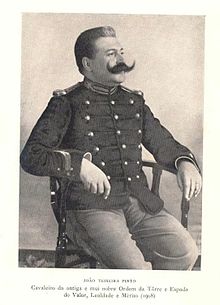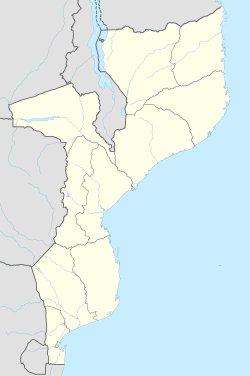Battle of Ngomano

Breakthrough of the protection force for German East Africa over the Rowuma (illustration by Carl Arriens ). In fact, there was no combat activity when the German troops crossed the river.
| date | November 25, 1917 |
|---|---|
| place | Ngomano , Portuguese East Africa |
| output | Victory of the German protection force |
| consequences | The German conquest of Ngomano allowed the Rovuma to pass through until the end of the war. |
| Parties to the conflict | |
|---|---|
| Commander | |
| Troop strength | |
| 1878 men 5000 people entourage |
900 men |
| losses | |
|
low |
200 dead and wounded |
1914
Maziua - Nyasa - Karonga - Zanzibar - Rufiji Delta - Kilimanjaro - Tanga
1915
Jassini - Bokuba - Lake Tanganyika
1916
Oldoboro (Salaita) - Reata-Latema - Tabora Offensive ( Tabora ) - Kahe - Kondoa Irangi - Matamondo - Kilosa - Mlali - Dutumi - Kisaki - Kibata
1917
Behobeho - Nambanje - Kiawe Bridge - Rumbo - Mahiwa - Mahenge - Ngomano
1918
Namacurra - Lioma - Pere Hills
Colonial troops of the German Empire and Portugal fought in the Battle of Ngomano ( Negomano ) during the First World War in East Africa . German troops under General Paul Emil von Lettow-Vorbeck , which consisted of Europeans and Askari , had previously won a victory against the British in the costly battle of Mahiwa (in today's Tanzania ). Now the German troops threatened to run out of supplies. To solve the problem, the Germans invaded Portuguese East Africa (today's Mozambique ). By going south, they avoided the British troops in the north and were able to supply themselves from captured Portuguese supplies.
The Portuguese troops who were supposed to stop von Lettow-Vorbeck at the border were under the command of Major João Teixeira Pinto . But they were attacked by the Germans on November 25, 1917 when they were camped near Ngomano. In the ensuing battle, the Portuguese troops were almost completely destroyed. Many of the Portuguese soldiers were killed or captured. The defeat of the Portuguese brought the Germans a large amount of supplies, which allowed von Lettow-Vorbeck to continue his operations in East Africa until the end of the war.
background
At the end of 1917, the Germans had few options if they wanted to continue the war in East Africa. They were vastly outnumbered and split up into several different columns. The two largest under Theodor Tafel and Paul Emil von Lettow-Vorbeck were cut off from each other. Von Lettow-Vorbeck's unit had previously been victorious in the battle of Mahiwa against a large British force, but had lost 500 to 600 men in the process. In addition, the German stocks of modern ammunition were almost exhausted. Only with antiquated weapons and no possibility of getting new equipment, von Lettow-Vorbeck decided to invade Portuguese East Africa in the hope of getting enough supplies to continue the war. Portugal was a member of the Entente , had been at war with Germany since March 9, 1916 and had sent an expeditionary force to France .
Tafel's unit had been intercepted by the Allies at the border and had to surrender. Von Lettow-Vorbeck reached the Rovuma , the border river between German and Portuguese East Africa. Since the supplies were insufficient, he was forced to dismiss a large part of the Askari, African auxiliary troops, as he could not adequately equip them. The general also sent away many civilians who followed the entourage.
With the reduced troops, von Lettow-Vorbeck planned to attack the Portuguese garrison in Ngomano on the other side of the river. The Portuguese troops were also mostly made up of locals. Their commander, the Portuguese João Teixeira Pinto, was a veteran with long combat experience in Africa.
Instead of building defensive positions, the Portuguese troops began to build a large military camp after their arrival on November 20th. Pinto had 900 men with six machine guns and a large supply store available, but the inexperienced troops had no chance against von Lettow-Vorbeck, who crossed the river with 1,500 to 2,000 battle-tested soldiers and numerous porters.
battle
On the morning of November 25th, the Portuguese garrison in Ngomano received a message from a British intelligence officer that an attack was imminent. Even so, the Portuguese were largely unprepared when the attack began. As a diversion, the Germans first shot at the camp with explosive bullets from across the river . Meanwhile, the German troops crossed the Rovuma further upstream, out of sight of the Portuguese. The Portuguese could not prevent the occupation of Ngomano. The Germans could easily attack the flanks of the Portuguese positions from the south, southwest and west and surround them with six infantry companies. Pinto had expected a frontal attack from the river, from the north, now it came from behind and completely surprised the Portuguese. The Portuguese tried to take cover but were completely disoriented after Pinto and several other officers fell early in the fight.
The Germans had relatively few heavy weapons, as they had thrown away most of their artillery and machine guns due to a lack of ammunition. Von Lettow-Vorbeck was nevertheless able to bring four machine guns close to the trenches, from where they were used at close range so as not to waste ammunition. The lack of combat experience meant the downfall of the Portuguese. Although they fired 30,000 rounds, the Germans suffered only very slight losses, including only one of their officers. The Portuguese had suffered heavy losses, lost their commanding officers, and were hopelessly outnumbered. So in the end they had to surrender, even though the large quantities of materials and supplies would have allowed them to continue the fight.
consequences
Location of Ngomano in present-day Mozambique |
The Germans had only a few deaths to complain about, a few askaris and a European officer. The Portuguese had to cope with a heavy defeat, especially since von Lettow-Vorbeck now had the opportunity to continue his campaign until the end of the war. The information on the losses among the Portuguese vary. Some sources speak of 200 soldiers killed or wounded and another 700 captured. Other sources speak of 25 Portuguese and 162 askaris who perished and 500 prisoners. The prisoners of war were used by the Germans as carriers for the 250,000 rounds of ammunition, six machine guns and several hundred rifles that the Germans had captured. The Germans had fully equipped their entire troop again. The Germans gave up most of their previous armament and destroyed them because there was no more ammunition available. Instead, they now used the Portuguese and British equipment. Even Portuguese uniforms were used to replace the worn German ones.
Von Lettow-Vorbeck did not stay long in Ngomano, but advanced south to attack other Portuguese positions. In Ngomano he only left one company to cover his back in case the British should follow him to Portuguese East Africa. Von Lettow-Vorbeck's troops won several more victories in which they captured more supplies and ammunition before they retreated to German East Africa in 1918 .
Web links
- Negomano 1917 (Portuguese)
supporting documents
- David F. Burg, L. Edward Purcell: Almanac of World War I . The University Press of Kentucky, Lexington, Kentucky 2004, ISBN 0-8131-2072-1 .
- Hugh Chisholm: The Encyclopædia Britannica, The Twelfth Edition, Volume 2 . The Encyclopædia Britannica Company, Ltd, New York 1922.
- Edmund Dane: British Campaigns in Africa and the Pacific, 1914-1918 . Hodder and Stoughton, London 1919.
- Walter Downes: With the Nigerians in German East Africa . Methuen & Co, London 1919.
- Malyn Newitt: A History of Mozambique . Indiana University Press, Bloomington 1995, ISBN 0-253-34006-3 .
- Edward Paice [2007]: Tip & Run: The Untold Tragedy of the Great War in Africa . Phoenix, London 2008, ISBN 978-0-7538-2349-1 .
- Hew Strachan: The First World War in Africa . Oxford University Press, Oxford 2004, ISBN 0-19-925728-0 .
Individual evidence
- ↑ Downes 1919, p. 179.
- ↑ Reinhard K. Lochner: Battle in the Rufiji Delta - The end of the small cruiser "Königsberg". The German Navy and Schutztruppe in East Africa during World War I. Wilhelm Heyne Verlag, Munich 1987, ISBN 3-453-02420-6 , p. 383.
- ↑ Chisholm 1922, p. 885.
- ^ Burg & Purcell 2004, p. 184.
- ↑ Chisholm 1922, p. 884.
- ↑ Strachan 2004, p. 175.
- ↑ Paice (2008, p. 340) names a Major Quaresma as the garrison commander, who actually stood above Pinto in the command hierarchy due to his longer service life. But he lacked combat experience.
- ↑ Downes 1919, p. 180.
- ↑ Newitt 1995, p. 419.
- ↑ Paice 2008, p. 339.
- ↑ Dane 1919, p. 150.
- ↑ Paice 2008, p. 339.
- ↑ Downes 1919, p. 179.
- ↑ However, Paice (2008, p. 339) states that after the battle a British agent visited the scene and reported that the Portuguese were already running out of food supplies, even if the garrison commander had reported sufficient supplies , would have been "on the verge of starvation".
- ↑ Downes 1919, p. 280.
- ↑ Dane 1919, p. 150.
- ↑ Paice (2008, p. 340) quoted by Lettow-Vorbeck, he estimated 200 deaths, 150 Europeans were released on probation and several hundred Askari were captured. Heinrich Schnee gives the lower numbers mentioned above.
- ↑ Paice 2008, p. 340.
- ↑ Dane 1919, p. 150.
- ↑ Downes 1919, p. 281.


